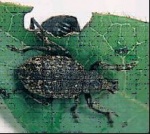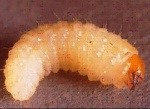Vine weevil
From Allotments4All
- Pest type: Insect
- Order: Coleoptera
- Scientific name: Otiorhynchus armadillo
- English name: Vine weevil
Signs of infestation: The adult weevil is difficult to spot, as it tends to hide away under debris during the day and feed at night. Larvae can be found within the soil around the root-ball of a wide range of plant species, and particularly in container grown plants.
Symptoms of infestation: Notches chewed in leaves by adults, particularly seen initially around the edges of the leaves, making them look unsightly. The plant may suddenly wilt as a result of damage caused by larvae feeding on roots.
Biology, reproduction and spread: The lifecycle is complete, with one generation in a year. Vine weevils are all female and reproduce by parthenogenesis. Adults emerge from the soil in early spring and commence feeding on leaves with their biting and chewing mouthparts, then lay eggs on the soil during spring and summer. The eggs hatch after around two to three weeks. The larvae emerge, and feed in the soil on plant roots with their biting mouthparts for around three to four months during summer and into autumn. In late autumn the larvae enter deeper into the soil. They pupate in winter in the soil. However, it is possible for the adult vine weevil and the larval stage to remain active during winter, especially in the sheltered conditions provided by container grown plants in nurseries. Although the adult is wingless, it is mobile during its reproductive stage and can crawl from place to place and over a potential two to three year life span is capable of laying many eggs.
Prevention and control treatments and methods.
Physical and cultural: Purchase container grown plants from a reputable source, and avoid any that show signs and symptoms of infestation. Remove any debris in which the adults can hide during the day. Traps formed from folded cloth or paper placed near plants can be inspected regularly for signs of the presence of adult vine weevils. Check plants regularly for signs and symptoms of infestation. Encourage natural predators such as ground beetles, birds, frogs and toads by providing habitats.
Biological – together with benefits and limitations: Apply a parasitic nematode such as Heterorhabditis megidis. This is purchased as a powder and then mixed with water and the soil is drenched with the suspension. The nematodes will enter the body of the larva and release a toxic bacterium that will kill the larva. The benefit of using this method is that the nematode is harmless to humans, so crops can be eaten safely. The effectiveness of the nematode is dependent upon the soil being moist, so the nematodes can move through it, and the soil temperature being consistently above 12oC, so the nematodes are active. There is no biological control for the adult weevil.
Chemical: Apply a contact insecticide as a soil drench containing imidacloprid or thiacloprid for larvae. Adults tend to be difficult to target effectively.
Legislative: None
How the pest affects the health and vitality of the host plant: Leaves are damaged although this is more unsightly than causing a serious problem. Roots are damaged, and the plant’s ability take up water and nutrients is impaired. The plant will not thrive. In the case of prolonged attack causing severe damage to roots, the death of the plant will ensue.


